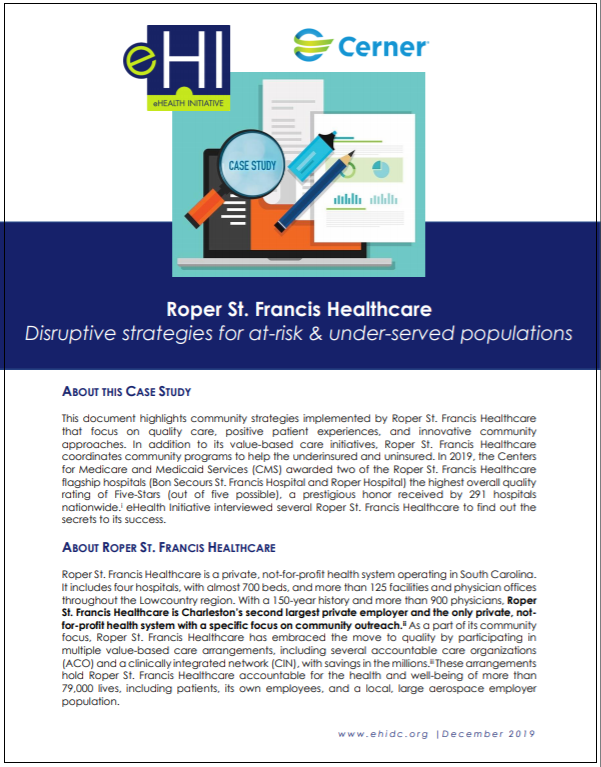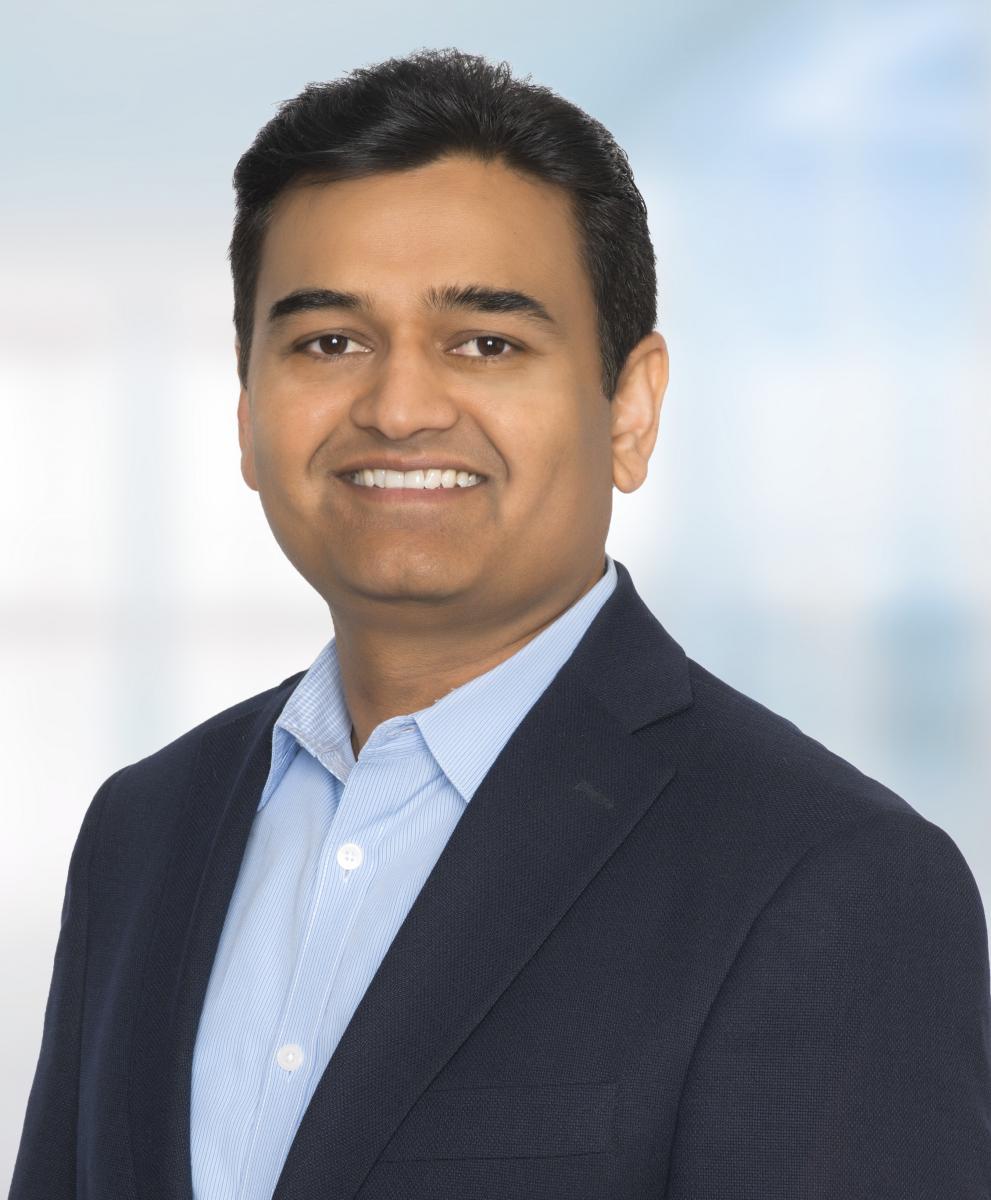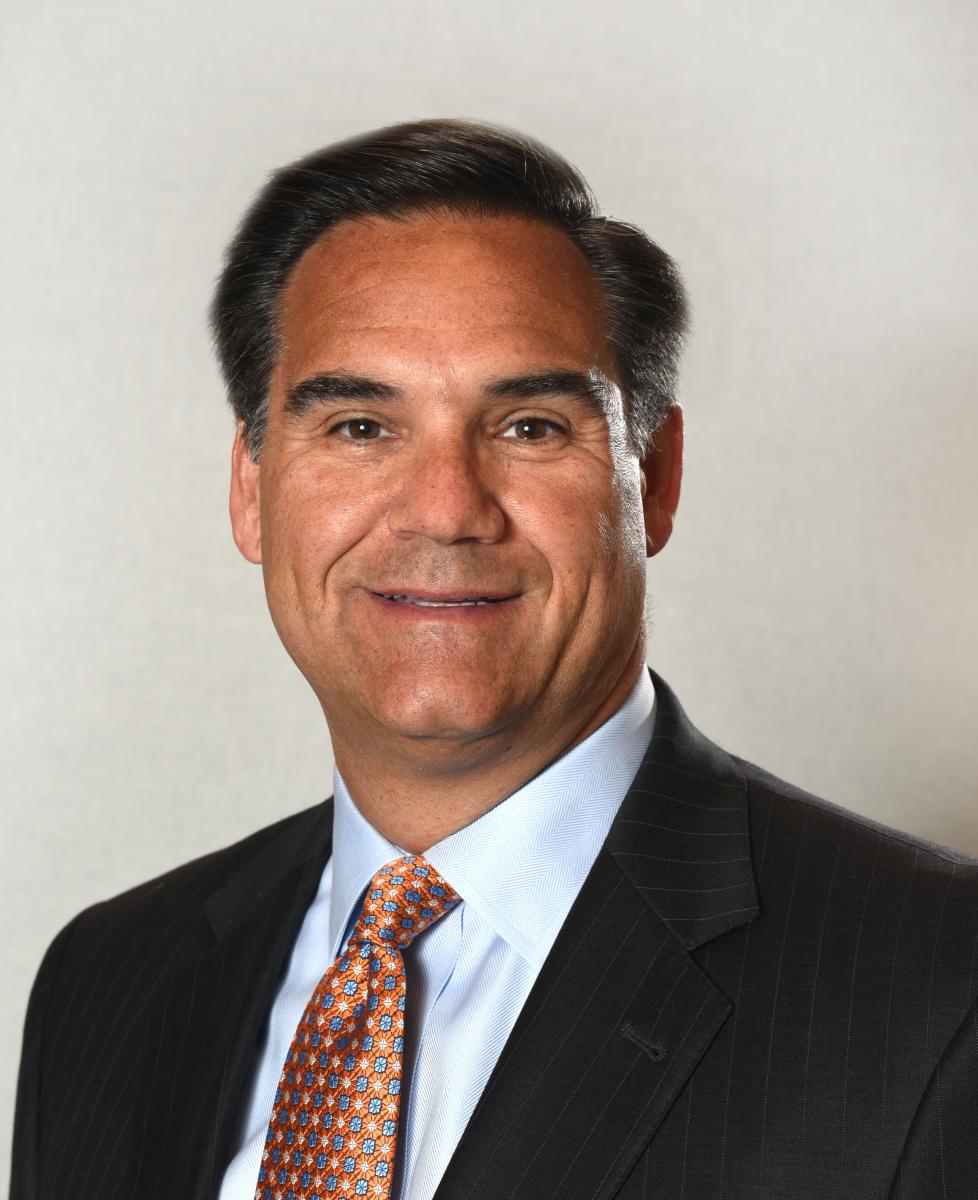Topic intro description here. Limited to 145 characters. Topic intro description here. Limited to 145 characters. Topic intro description here.
Roper St. Francis Case Study
 This document highlights community strategies implemented by Roper St. Francis Healthcare that focus on quality care, positive patient experiences, and innovative community approaches. In addition to its value-based care initiatives, Roper St. Francis Healthcare coordinates community programs to help the underinsured and uninsured. In 2019, the Centers for Medicare and Medicaid Services (CMS) awarded two of the Roper St. Francis Healthcare flagship hospitals (Bon Secours St. Francis Hospital and Roper Hospital) the highest overall quality rating of Five-Stars (out of five possible), a prestigious honor received by 291 hospitals nationwide. eHealth Initiative interviewed several Roper St. Francis Healthcare to find out the secrets to its success.
This document highlights community strategies implemented by Roper St. Francis Healthcare that focus on quality care, positive patient experiences, and innovative community approaches. In addition to its value-based care initiatives, Roper St. Francis Healthcare coordinates community programs to help the underinsured and uninsured. In 2019, the Centers for Medicare and Medicaid Services (CMS) awarded two of the Roper St. Francis Healthcare flagship hospitals (Bon Secours St. Francis Hospital and Roper Hospital) the highest overall quality rating of Five-Stars (out of five possible), a prestigious honor received by 291 hospitals nationwide. eHealth Initiative interviewed several Roper St. Francis Healthcare to find out the secrets to its success.
Unpacking the Black Box in Artificial Intelligence for Medicine
Unpacking the Black Box in Artificial Intelligence for Medicine
In clinics around the world, a type of artificial intelligence called deep learning is starting to supplement or replace humans in common tasks such as analyzing medical images. Already, at Massachusetts General Hospital in Boston, “every one of the 50,000 screening mammograms we do every year is processed through our deep learning model, and that information is provided to the radiologist,” says Constance Lehman, chief of the hospital’s breast imaging division.
In deep learning, a subset of a type of artificial intelligence called machine learning, computer models essentially teach themselves to make predictions from large sets of data. The raw power of the technology has improved dramatically in recent years, and it’s now used in everything from medical diagnostics to online shopping to autonomous vehicles.
But deep learning tools also raise worrying questions because they solve problems in ways that humans can’t always follow. If the connection between the data you feed into the model and the output it delivers is inscrutable — hidden inside a so-called black box — how can it be trusted? Among researchers, there’s a growing call to clarify how deep learning tools make decisions — and a debate over what such interpretability might demand and when it’s truly needed. The stakes are particularly high in medicine, where lives will be on the line.
The full Undark article can be viewed at this link.
Here’s How Health Data Can Help Stem the Opioid Crisis
Here’s How Health Data Can Help Stem the Opioid Crisis
The number of people losing their lives each day to prescription or illicit opioid-related overdoses is staggering. According to the Centers for Disease Control and Prevention, more than 47,000 Americans died in 2017 — 130 fatalities each day — due to opioid overdoses, making it the deadliest year on record.
You don’t have to be personally touched by the opioid crisis to understand the gravity of the statistics, let alone the immeasurable and lasting impact it is having on society. This can be addressed by better harnessing the power of data to stem this crisis.
The full Morning Consult article can be viewed at this link.
5 Ways Technology Will Enable Value-Based Care in 2020 and Beyond
5 Ways Technology Will Enable Value-Based Care in 2020 and Beyond
If your first thought while reading that statement was, “I’ve heard that before – and nothing actually ever changes,” your skepticism is well founded, as industry experts have been purporting significant transformation for at least a decade. However, I truly believe we’ve reached a tipping point, and that consumers will see real healthcare change in the near future. It’s a bold statement to make, but there are a few forces at work that I believe will make it true — namely, the intersection of value-based care and technological innovation.
- Digital Therapeutics: Engaging With Patients During Recovery
- Promoting Patient Wellness With Wearables
- Price Transparency: What’s The Cost Of My Care?
- Healthcare, Personalized: Precision Medicine and Genetics
- Dr. A.I. Will See You Now
The full Forbes article can be viewed at this link.
Validation of use of billing codes for identifying telemedicine encounters in administrative data
Validation of use of billing codes for identifying telemedicine encounters in administrative data
Telemedicine is the use of telecommunication technology to remotely provide healthcare services. Evaluation of telemedicine use often relies on administrative data, but the validity of identifying telemedicine encounters in administrative data is not known. The objective of this study was to assess the accuracy of billing codes for identifying telemedicine use.
In this retrospective study of encounters within a large integrated health system from January 2016 to December 2017, we examined the accuracy of billing codes for identifying live-interactive and store-and-forward telemedicine encounters compared to manual chart review. To further examine external validity, we applied these codes and assessed patient and visit characteristics for identified live-interactive telemedicine encounters and storeand-forward telemedicine encounters in a second data set.
In manual review of 390 encounters, 75 encounters were live-interactive telemedicine and 158 were storeand-forward telemedicine. In weighted analysis, the presence of the GT modifier in the absence of the GQ modifier or CPT code 99444 yielded 100% sensitivity and 99.99% specificity for identification of live-interactive telemedicine encounters. The presence of either the GQ modifier or the CPT code 99444 had 100% sensitivity and 100% specificity for identification of store-and-forward telemedicine encounters. Applying these algorithms to a second data set (n = 5,917,555) identified telemedicine encounters with expected patient and visit characteristics.
These findings provide support for use of CPT codes to perform telemedicine research in administrative data, aiding ongoing work to understand the role of non-face-to-face care in optimizing health care delivery.
The full article can be downloaded below.
As Healthcare Goes Digital, Social Care Lags Behind
As Healthcare Goes Digital, Social Care Lags Behind
Since 2009, federal legislation has awarded billions of dollars to physicians and hospitals that make health information technology part of their practice. While many highlighted the downsides of digitization, the providers who unlock its full potential know very well that it benefits clinical care immensely.
Most social care organizations, however, were left untouched by this outpouring of funds—not for lack of necessity, but their inability to qualify. Although their exclusion was no doubt a missed opportunity, digital tools and data solutions have emerged over the past decade that can more than make up for lost time.
The reasons for digitizing social care are as numerous as the challenges that come with it. Here are a few of each.
The full Forbes article can be viewed at this link.
WHO HEALTH AND CLIMATE CHANGE SURVEY REPORT
WHO HEALTH AND CLIMATE CHANGE SURVEY REPORT
This report presents global findings from the 2017/2018 WHO Health and Climate Change Survey completed by national health services. Regular updates on key health and climate change indicators empower policy makers to make more informed choices to: assess the implementation of policies and plans, identify gaps in evidence, and better understand the barriers to achieving health adaptation and mitigation priorities. This report provides a vital snapshot of the overall progress that governments have made in the field of health and climate change to date, as well as insight into what work remains in order to protect their populations from the most devastating health impacts of climate change.
The full report can be downloaded below.
Top 8 Predictions That Will Disrupt Healthcare in 2020
Top 8 Predictions That Will Disrupt Healthcare in 2020
Every year, our team of futurists, analysts, and consultants at Frost & Sullivan's Transformational Healthcare Group comes together to brainstorm and predict the themes, technologies, and global forces that will define the next 12 to 18 months for the healthcare industry. We also retrospect how we did each year, and each year we are becoming more accurate in the predictions we make. For the 2019 predictions that were released in November 2018, six out of eight predictions realized as anticipated, while the two remaining predictions have not panned out exactly the way we thought.
The new vision for healthcare for 2020 and beyond will not just focus on access, quality, and affordability but also on predictive, preventive, and outcome-based care models promoting social and financial inclusion. As we are on the verge of entering a new decade of change globally, 2020 will be a reality check for long-pending national healthcare policies and regulatory reforms that must reinvigorate future strategies. China will continue to catch up to the US on some important health metrics as it strives to become the “world’s best and cheapest health system.”
The top 8 predictions for 2020 are as follows:
- SDOH analytics platform gains traction during 2020
- AI develops more use cases and faces more ethical challenges, beginning with radiology
- Annuity-based model to catapult gene therapy commercialization
- Continued VC funding mega-rounds make 2020 a banner year for Digital Health Unicorns’ IPO exits
- Interoperability by pure-play solution vendors will gain ground against standalone systems
- Telehealth will gain mainstream adoption in the overall mix of healthcare services and will expand beyond the current focus on chronic conditions
- Precision medicine-led approaches will pave the way for next-gen health data analytics solutions
- 2020 will be a year of ‘Retailization’ for the healthcare industry, promoting the ‘Comparison Shopping’ consumer mindset
The full Forbes article can be viewed at this link.
Webinar Presentation: Beyond the EHR - A Data Driven Healthcare System
In this webinar Geisinger Health System and Hackensack Meridian Health discussed considerations and successes of implementing an EHR- and source-agnostic data and insights platform that sits above the EHR. The result: aggregated, normalized, consumable insights that provide your system and users a more 360-degree view of a population. A link to the presentation is down below. Data is collected from all over, both inside and outside of your organization. Tons of it, in fact. Geisinger and Hackensack offer solutions to help you figure out what you can when it’s everywhere, unorganized and unfiltered. It’s time to start connecting the information inside all your systems.
Speakers
 Greg Strevig is the Vice president of Enterprise Analytics at Geisinger Health System. Mr. Strevig is responsible for business intelligence across all Geisinger’s business domains, including the Clinical Enterprise, Geisinger Health Plan, Geisinger Commonwealth School of Medicine, and all operational and administrative towers. Mr. Strevig is currently enabling the new Geisinger Data Informatics Center of Excellence pulling together 100+ business intelligence and analytics personnel to create a coordinated and high-performance analytics function.
Greg Strevig is the Vice president of Enterprise Analytics at Geisinger Health System. Mr. Strevig is responsible for business intelligence across all Geisinger’s business domains, including the Clinical Enterprise, Geisinger Health Plan, Geisinger Commonwealth School of Medicine, and all operational and administrative towers. Mr. Strevig is currently enabling the new Geisinger Data Informatics Center of Excellence pulling together 100+ business intelligence and analytics personnel to create a coordinated and high-performance analytics function.
 Bharat Sutariya, MD, FACEP is the vice president and chief medical officer of population health at Cerner. Dr. Sutariya is responsible for leading population health innovation strategy and strategic client advancement. He collaborates with leaders across Cerner, strategic clients and industry to enhance Cerner’s industry leading data and insights platform, intelligence and solutions. His work has enabled Cerner to provide comprehensive solutions to health care delivery systems, employers, government and sponsors of health care across the globe to meet diverse needs in this dynamic era of transition to value-based care. Dr. Sutariya is a strong advocate of big data-driven innovation in health care with special interest in advanced clinical intelligence and health care economics. He continues to practice Emergency Medicine at Olathe Medical Center in Olathe, Kansas.
Bharat Sutariya, MD, FACEP is the vice president and chief medical officer of population health at Cerner. Dr. Sutariya is responsible for leading population health innovation strategy and strategic client advancement. He collaborates with leaders across Cerner, strategic clients and industry to enhance Cerner’s industry leading data and insights platform, intelligence and solutions. His work has enabled Cerner to provide comprehensive solutions to health care delivery systems, employers, government and sponsors of health care across the globe to meet diverse needs in this dynamic era of transition to value-based care. Dr. Sutariya is a strong advocate of big data-driven innovation in health care with special interest in advanced clinical intelligence and health care economics. He continues to practice Emergency Medicine at Olathe Medical Center in Olathe, Kansas.
 Patrick Young is the president of Population Health at Hackensack Meridian Health. Mr. Young is responsible for accelerating the development of strategic priorities related to health care reform; population health management; Hackensack Meridian Health Partners, Hackensack Meridian Health’s clinically integrated network; managed care contracting; Hackensack Meridian Health’s three Medicare Shared Savings Program (MSSP) Accountable Care Organizations (ACO); as well as overseeing care coordination, health insurance partnerships, and data analytics and data management.
Patrick Young is the president of Population Health at Hackensack Meridian Health. Mr. Young is responsible for accelerating the development of strategic priorities related to health care reform; population health management; Hackensack Meridian Health Partners, Hackensack Meridian Health’s clinically integrated network; managed care contracting; Hackensack Meridian Health’s three Medicare Shared Savings Program (MSSP) Accountable Care Organizations (ACO); as well as overseeing care coordination, health insurance partnerships, and data analytics and data management.
For more information on data and insights platforms, check out our report on the topic.
Will Artificial Intelligence Translate Big Data Into Improved Medical Care or Be a Source of Confusing Intrusion? A Discussion Between a Physician Informatician and a Medical Informatics Researcher
Will Artificial Intelligence Translate Big Data Into Improved Medical Care or Be a Source of Confusing Intrusion? A Discussion Between a Physician Informatician and a Medical Informatics Researcher
Artificial intelligence (AI), the computerized capability of doing tasks, which until recently was thought to be the exclusive domain of human intelligence, has demonstrated great strides in the past decade. The abilities to play games, provide piloting for an automobile, and respond to spoken language are remarkable successes. How are the challenges and opportunities of medicine different from these challenges and how can we best apply these data-driven techniques to patient care and outcomes? A New England Journal of Medicine paper published in 1980 suggested that more well-defined “specialized” tasks of medical care were more amenable to computer assistance, while the breadth of approach required for defining a problem and narrowing down the problem space was less so, and perhaps, unachievable. On the other hand, one can argue that the modern version of AI, which uses data-driven approaches, will be the most useful in tackling tasks such as outcome prediction that are often difficult for clinicians and patients. The ability today to collect large volumes of data about a single individual (eg, through a wearable device) and the accumulation of large datasets about multiple persons receiving medical care has the potential to apply to the care of individuals. As these techniques of analysis, enumeration, aggregation, and presentation are brought to bear in medicine, the question arises as to their utility and applicability in that domain. Early efforts in decision support were found to be helpful; as the systems proliferated, later experiences have shown difficulties such as alert fatigue and physician burnout becoming more prevalent. Will something similar arise from data-driven predictions? Will empowering patients by equipping them with information gained from data analysis help? Patients, providers, technology, and policymakers each have a role to play in the development and utilization of AI in medicine. Some of the challenges, opportunities, and tradeoffs implicit here are presented as a dialog between a clinician (SJN) and an informatician (QZT).
The full article can be downloaded below.
